
In November I had a big birthday to celebrate and did so in style staying in a quirky 15th century cottage right in the middle of Canterbury. One of the previous owners of the property was Nat Field, an actor and dramatist who would have been a contemporary of Marlowe and Shakespeare. His father, John Field, was a puritan who disapproved of all the entertainments his son was involved in. Apparently Nat was a bit of a ladies man who led a wild life and may have fathered a child with the Duchess of Argyll. His name appears as one of the actors in the 1623 First Folio of Shakespeare’s plays. He may well have replaced Shakespeare when he joined the King’s Men in 1616. Like Shakespeare, he spent most of his life in London, presumably retiring to Canterbury, although details are scant, apparently he was forced to quit the stage after a scandal. A facsimile of his portrait watched us from the wall in the bedroom in that eerie way that old portraits do, the original is in the Dulwich Picture Gallery and is impossibly romantic in that wild haired piratic way that a young Shakespeare and Marlowe are depicted… Christopher Marlowe, son of a Canterbury shoemaker, is probably one of the most lauded connections and the cottage was a minute away from the stupendous Marlowe Theatre. So little seems to be known about Nat Field beyond his professional life, he feels ripe for the picking for any budding novelists out there. Susan Cooper, in her children’s novel, King of Shadows, features Nathan Field as a character. Set in 1599, it uses Field’s background as a student of Richard Mulcaster’s at St Paul’s as a springboard. The Nathan Field in the story, who briefly works at Shakespeare’s Globe Theatre, is actually a like-named boy from 1999, who has switched places with the young Elizabethan actor. As you can tell I became rather besotted with the romance of all this!

The current owner is also an actor and the cottage was festooned with theatre posters, TV scripts (he was in The Bill for many years) and original artwork.

Canterbury has connections with so many literary figures, including Rupert Bear! Mary Tourtel lived all her life in Canterbury, creating Rupert in 1920 for the Daily Express. Rupert was conceived as a rival to Teddy Tail, who was the star of a popular comic strip in The Daily Mail. When Tourtel’s eyesight deteriorated too much to continue with her illustrations in the 1930s, Alfred Bestall was her replacement. I adore Rupert. We have two framed snowy scenes from a Rupert calendar which come out every Christmas as part of the festivities and a framed Bill Badger scene in our porch!
Chaucer succeeded in putting Canterbury on the map early on with The Canterbury Tales, written between 1387 and 1400 and available in a printed edition from 1476. The reader follows a group of pilgrims from Southwark to Canterbury where they are to visit the tomb of the martyred Bishop, Thomas à Beckett. Their individual tales told in the inns they stay in along the way form the narrative.
Aphra Behn was born just outside Canterbury. She was one of the first English women to earn her living as a writer although, before she became a poet, translator and playwright she was a spy in Antwerp for the Court of Charles II! Just as little is known about Nat Field, or even Shakespeare, and the true nature of Marlowe’s death, Aphra Behn is also somewhat of a mystery. Her biographer, Janet Todd, laments, “she has a lethal combination of obscurity, secrecy and staginess which makes her an uneasy fit for any narrative, speculative or factual. She is not so much a woman to be unmasked as an unending combination of masks.” I do love a shadowy figure that allows space for speculation!
Dickens knew Kent well. In addition to his London residence, he had a house just outside Gravesend, Gad’s Hill Place, for the last fourteen years of his life and had spent much of his youth in Kent. Legend has it that he had always coveted the house, which he had seen on country walks with his father, and he expresses this in The Uncommercial Traveller, a collection of literary sketches and reminiscences:
“Bless you, sir,” said the very queer small boy, “when I was not more than half as old as nine, it used to be a treat for me to be brought to look at it. And now, I am nine, I come by myself to look at it. And ever since I can recollect, my father, seeing me so fond of it, has often said to me, ‘If you were to be very persevering and were to work hard, you might some day come to live in it.’ Though that’s impossible!” said the very queer small boy, drawing a low breath, and now staring at the house out of the window with all his might.
Still from Daved Lean’s 1946 film of “Great Expectations”:

Dickens wrote Great Expectations in his Kent house, penning some wonderfully evocative descriptions of the marshes:
The marshes were just a long black horizontal line … the river was just another horizontal line, not nearly so broad nor yet so black, and the sky was just a row of long angry red lines and dense black lines intermingled …The dark flat wilderness, intersected with dykes and mounds and gates, with scattered cattle feeding on it…the low leaden line of the river…and the distant savage lair from which the wind was rushing, the sea…
I am used to marshland as we have a lot of saltmarshes in North Norfolk, but the Kent marshes seem bleaker and wilder and Dickens captures this desolation and isolation so well. The marshes between Whitstable and Faversham seem unchanged since Magwitch leapt out and terrified poor Pip. Part of the Thames Estuary they used to stretch right up to Westminster and have been drained and embanked since the 12th century. One of my favourite days out during our week away was a trip to Faversham and a long loop into the countryside and back along the saltmarsh. The town is full of medieval buildings, breweries and quirky shops but one of the sights that interested me most of all was
 the Cardox factory (left), which opened in 1924 and was part of Faversham’s once extensive explosives industry. Today it looks derelict, but the sheds are still in operation and are deliberately flimsy and far apart from each other to prevent fires spreading and to allow easy rebuilding should an internal explosion occur. Closer to Faversham town is the Chart Gunpowder Mill, the oldest of its kind in the world. Ships would transport the gunpowder along the creek and out via the Medway and Thames to the royal arsenals at Chatham or the Tower of London. You could even argue that the Battle of Trafalgar in 1805 was won in the gunpowder factories of Faversham. Nelson’s ship, HMS Victory, carried 35 tonnes of powder to supply its cannon. I like pretty places but find myself drawn much more to traces of industry and spent ages peeking through the fence at these tumbledown sheds!
the Cardox factory (left), which opened in 1924 and was part of Faversham’s once extensive explosives industry. Today it looks derelict, but the sheds are still in operation and are deliberately flimsy and far apart from each other to prevent fires spreading and to allow easy rebuilding should an internal explosion occur. Closer to Faversham town is the Chart Gunpowder Mill, the oldest of its kind in the world. Ships would transport the gunpowder along the creek and out via the Medway and Thames to the royal arsenals at Chatham or the Tower of London. You could even argue that the Battle of Trafalgar in 1805 was won in the gunpowder factories of Faversham. Nelson’s ship, HMS Victory, carried 35 tonnes of powder to supply its cannon. I like pretty places but find myself drawn much more to traces of industry and spent ages peeking through the fence at these tumbledown sheds!
Faversham Creek was bleak and beautiful on the very cold and windswept day when we did our walk. Daniel Defoe, a customs officer, knew Faversham well, stating in 1724,
“in the arts of that wicked trade the people hereabouts are arrived at such a proficiency that they are
grown monstrous rich.”
The “wicked trade” is, of course, smuggling.
As we got closer to Faversham on our looping walk we had to cross a small wooden bridge over Cooksditch Stream into Ironwharf Boatyard. On the other side of the bridge was a very welcome mirage, Quint’s Retreat. This tiny vintage caravan, run by a cheery lady, supplies tea, cake, bacon butties and toasties to dogwalkers, boatbuilders and very cold tourists. It’s named after Robert Shaw’s character in “Jaws” and was totally unexpected. The boatyard housed some real treasures alongside decommissioned goods wagons which were stranded when a section of the railway track was dismantled.

Faversham’s architecture is outstanding and another of my favourites was this magnificent warehouse (below) which stored locally grown hops ready to be transported up the creek to the London Hop Exchange. My mother’s family were East Enders and, during the war they spent a lot of time living in Kent hop huts, bringing in the harvest and part of their evacuation duties. My aunt remembers the whole family living in one hut with all the kids joining in at harvest time and my Nan sitting in state ready to receive the hopheads.
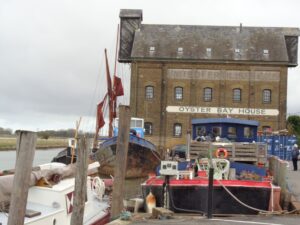
There was so much more to explore in Faversham, such as the remnants of the once thriving brick industry and the priory and abbey vestiges. The four-mile walk took us all day to complete and it felt as if there was much more to discover in Faversham’s layered history.
Another passion of mine is run-down seaside places. Fortunately, we were a stone’s throw from the coast as I start to pine if I can’t get to the sea regularly. As well as a brilliant trip to Whitstable we also walked from Margate to Ramsgate. I’d love to go to Dreamland, Margate’s vintage theme park dating back from the end of the nineteenth century when an entrepreneur reclaimed it from the saltmarsh. It’s changed a lot since then, of course, and its current status is a little hazy. We could see into the site from our train to Margate and it looked fantastic. The boards around the site contain some wonderful artwork combined with the memories of locals:

As the text is a bit blurry, but also totally brilliant, I’ve transcribed it here:
“My best birthday my Mum made me a cake in the shape of a thatched cottage.”
“When the candles were lit, the shredded wheat roof caught fire and my Dad drove a toy fire engine in NEE NAW NEE NAW! and poured water on!”
The town itself is a strange mixture of decrepit and genteel and all the bits in between. Tracey Emin clearly had a large part to play in putting Margate back on the map from its heyday as a popular seaside resort. Over Droit House, one of the most distinctive buildings on the seafront, is Emin’s neon artwork “I never stopped loving you,” her love letter to the town where she grew up.
T S Eliot wrote part of The Wasteland in Margate. There’s a really interesting article here:
https://www.theguardian.com/books/2009/nov/09/ts-eliot-waste-land-margate
And a great quote in the waiting room/toilets area of Margate Station:

“My name is only an anagram for toilets.”
T S Eliot
As we walked along the front for our walk to Ramsgate we were surprised to see a figure seemingly standing in the sea as the waves washed over his head. A bit of zooming and googling with phones and cameras showed that it was, in fact, one of Anthony Gormley’s Another Time cast iron figures (number 23 out of the hundred cast, to be precise). They have been placed all over the world and are very similar to the Another Place figures, again 100 in total, all facing out to sea on Crosby Sands. It felt as if one of these figures had waded round the coast until it came to rest in Margate.

The walk to Ramsgate was splendid. One of the highlights was this amazing chalk arch on Kingsgate Bay on the way to Broadstairs.

And another highlight was Broadstairs itself with its distinctive bay and Dickens connections. I spent a couple of years in Broadstairs as a very young child and have very blurred memories of it, I think I was about eighteen months old or younger when we arrived and getting on for four when we left. But I’m sure I remember Morelli’s and who wouldn’t? It’s an institution and provided a great rest-stop for the final leg of our walk.

Canterbury was a great base and we explored the town and Cathedral thoroughly, but it was the harsh landscapes of the Kent coast and countryside which really spoke to me. I’m sure there are poems brewing, particularly from the weird and wonderful sculptures, found pieces I snapped along the way!


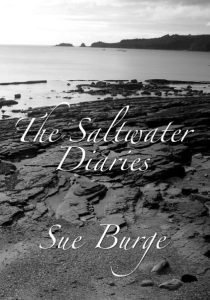 I’m delighted to announce that my new pamphlet (or chapbook as my American friends call it), The Saltwater Diaries, will be coming out in September. The collection explores my relationship with the sea, formed over the last five decades and more, and features poems mostly written since moving to a house which is a seven-minute-walk from the sea. Many of the poems mention swimming and, as it’s the season for sea swimming (well, for me, anyway, not being quite as hardy as some I know who swim all year round!) I thought it would be a good time to reflect on the joys of wild swimming.
I’m delighted to announce that my new pamphlet (or chapbook as my American friends call it), The Saltwater Diaries, will be coming out in September. The collection explores my relationship with the sea, formed over the last five decades and more, and features poems mostly written since moving to a house which is a seven-minute-walk from the sea. Many of the poems mention swimming and, as it’s the season for sea swimming (well, for me, anyway, not being quite as hardy as some I know who swim all year round!) I thought it would be a good time to reflect on the joys of wild swimming.






 I’ve just returned from my second Arvon course under the Arts Council grant, this time at Lumb Bank, an imposing eighteenth century mill owner’s manse glowering down a steeply wooded hillside to where the ruined mill chimneys can still be seen. The concept of Arvon, the grandaddy of UK creative writing courses, was founded in Devon by poets John Moat and John Fairfax in l968 as a reaction against what they saw as a staid, dogmatic approach to teaching poetry. Lumb Bank was Ted and Carol Hughes’ home for a short while and was leased to Arvon when Hughes suggested it was time to open a Northern centre. The Arvon formula is the same in all three centres: two tutors, a guest reader mid-week and up to 16 anxious but starry-eyed participants. Fantastic poets and tutors Jean Sprackland and Jacob Polley had fun with an ever-changing good cop/bad cop formula and knocked us all into better shape with grace, sensitivity and humour, coaxing (or, perhaps, ripping!) seven very different poems out of me in just four days. Sean Borodale arrived on Wednesday night for his guest slot looking like a floppy-haired 21st century version of Keats to read his profound and erudite poems on subjects ranging from peeling and stewing apples to an extraordinary contemplation of a queen bee…
I’ve just returned from my second Arvon course under the Arts Council grant, this time at Lumb Bank, an imposing eighteenth century mill owner’s manse glowering down a steeply wooded hillside to where the ruined mill chimneys can still be seen. The concept of Arvon, the grandaddy of UK creative writing courses, was founded in Devon by poets John Moat and John Fairfax in l968 as a reaction against what they saw as a staid, dogmatic approach to teaching poetry. Lumb Bank was Ted and Carol Hughes’ home for a short while and was leased to Arvon when Hughes suggested it was time to open a Northern centre. The Arvon formula is the same in all three centres: two tutors, a guest reader mid-week and up to 16 anxious but starry-eyed participants. Fantastic poets and tutors Jean Sprackland and Jacob Polley had fun with an ever-changing good cop/bad cop formula and knocked us all into better shape with grace, sensitivity and humour, coaxing (or, perhaps, ripping!) seven very different poems out of me in just four days. Sean Borodale arrived on Wednesday night for his guest slot looking like a floppy-haired 21st century version of Keats to read his profound and erudite poems on subjects ranging from peeling and stewing apples to an extraordinary contemplation of a queen bee…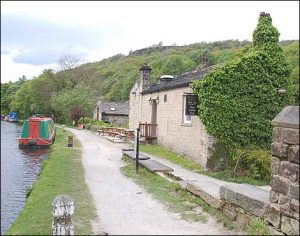 The weather was glorious except for the day I had cooking and washing up duty (sometimes the best-laid plans actually work out!). I did a daily walk down to Hebden Bridge to sit by the canal with a beer at Stubbings Wharf or a coffee at The Den watching the sun on the painted barges and dodging the hissing geese before the steep walk back up via Heptonstall.
The weather was glorious except for the day I had cooking and washing up duty (sometimes the best-laid plans actually work out!). I did a daily walk down to Hebden Bridge to sit by the canal with a beer at Stubbings Wharf or a coffee at The Den watching the sun on the painted barges and dodging the hissing geese before the steep walk back up via Heptonstall.  Sylvia Plath is buried in the new graveyard in this village which is a fifteen-minute walk from Lumb Bank. I’ve been to this area quite a bit and was glad that I’d already “done” my Sylvia Plath poem some years back – it’s hard not to be influenced by these two extraordinary poets and hard not to let the beauty and harshness of nature overwhelm your poems. There was even a cat called Ted, although it was from the farm down the road and turned out to be a girl…
Sylvia Plath is buried in the new graveyard in this village which is a fifteen-minute walk from Lumb Bank. I’ve been to this area quite a bit and was glad that I’d already “done” my Sylvia Plath poem some years back – it’s hard not to be influenced by these two extraordinary poets and hard not to let the beauty and harshness of nature overwhelm your poems. There was even a cat called Ted, although it was from the farm down the road and turned out to be a girl…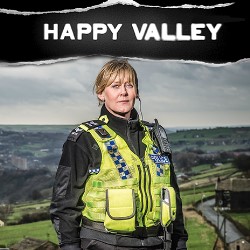 I discovered that one of the participants on the course had stayed in the same cottage in Mytholmroyd last April that Chris and I had rented in November during my birthday week. One of my presents was the first series of Happy Valley – it was a rainy week and we couldn’t stop watching it. Sally Wainwright’s flawless script, superb acting from a wonderful cast, particularly Sarah Lancashire and James Norton, and the fact that every night we walked along the dark canal back from Hebden Bridge to Mytholmroyd, passing the exact spot where the chillingly psychopathic Tommy Lee Royce had been hiding, all added to the dark and rather magnificent claustrophobia which permeates the Calder Valley on winter days. Sally Wainwright went to school in Sowerby Bridge and most of her scripts touch on this area (Sparkhouse, Scott and Bailey, Unforgiven etc) and, of course, Catherine Cawood, Sarah Lancashire’s character in Happy Valley, is often seen in Heptonstall at the graveside of her daughter Rebecca who is the invisible motivating factor behind the whole series. Calderdale has been used as a feature film location since Cecil Hepworth’s Helen of the Four Gates in 1920 and, with its sinister moor and heathlands, steep climbs, cobbled villages and solid stone buildings, it never fails to be a character in its own right.
I discovered that one of the participants on the course had stayed in the same cottage in Mytholmroyd last April that Chris and I had rented in November during my birthday week. One of my presents was the first series of Happy Valley – it was a rainy week and we couldn’t stop watching it. Sally Wainwright’s flawless script, superb acting from a wonderful cast, particularly Sarah Lancashire and James Norton, and the fact that every night we walked along the dark canal back from Hebden Bridge to Mytholmroyd, passing the exact spot where the chillingly psychopathic Tommy Lee Royce had been hiding, all added to the dark and rather magnificent claustrophobia which permeates the Calder Valley on winter days. Sally Wainwright went to school in Sowerby Bridge and most of her scripts touch on this area (Sparkhouse, Scott and Bailey, Unforgiven etc) and, of course, Catherine Cawood, Sarah Lancashire’s character in Happy Valley, is often seen in Heptonstall at the graveside of her daughter Rebecca who is the invisible motivating factor behind the whole series. Calderdale has been used as a feature film location since Cecil Hepworth’s Helen of the Four Gates in 1920 and, with its sinister moor and heathlands, steep climbs, cobbled villages and solid stone buildings, it never fails to be a character in its own right.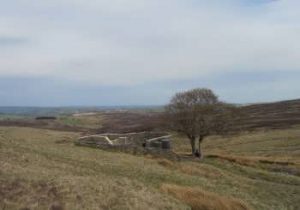 On my birthday we walked from Haworth back to Hebden Bridge via Top Withens (Wuthering Heights to you and me!) on the kind of foggy day that just makes you want to write intensely passionate and romantic poetry (although I was slightly distracted by the fact that I’d turned my left eye into a giant purple puffball by picking a mushroom, trying to identify it and then rubbing my eye…)
On my birthday we walked from Haworth back to Hebden Bridge via Top Withens (Wuthering Heights to you and me!) on the kind of foggy day that just makes you want to write intensely passionate and romantic poetry (although I was slightly distracted by the fact that I’d turned my left eye into a giant purple puffball by picking a mushroom, trying to identify it and then rubbing my eye…) We also had a rather more up-to-date and positively post-apocalyptic experience that week when we went to the fantastic Trades Club on Hallowe’en to see a screening of Last Man on Earth, a schlocky B-movie made in Italy at the height of the horror era in 1968 (adapted from Richard Matheson’s novel I Am Legend and remade under this title in 2007 with Will Smith. There’s also a 1971 remake, The Omega Man, starring Charlton Heston). It stars Vincent Price as Dr Robert Morgan who wakes every morning in his garlic- festooned house to go vampire hunting (the film’s baddies are a confusing mix of zombie and vampire). The screening was accompanied with live music from Animat who used a mixture of their own brand of dubby downtempo music as well as an eclectic selection of tracks from their DJ archive including, inevitably, Thriller! Holme Street, where the Trades Club is situated, is a cul-de-sac T-junctioned by the Rochdale Canal and it tends to attract all sorts at night… We emerged into the darkness to be met by a ragged bunch of men staggering around in an inarticulate manner with an excitable black dog, echoing the repeated scenes in The Last Man on Earth where Vincent Price encounters angry zombies every morning when he opens his door and he even inadvertently adopts a zombie dog (black, of course!).
We also had a rather more up-to-date and positively post-apocalyptic experience that week when we went to the fantastic Trades Club on Hallowe’en to see a screening of Last Man on Earth, a schlocky B-movie made in Italy at the height of the horror era in 1968 (adapted from Richard Matheson’s novel I Am Legend and remade under this title in 2007 with Will Smith. There’s also a 1971 remake, The Omega Man, starring Charlton Heston). It stars Vincent Price as Dr Robert Morgan who wakes every morning in his garlic- festooned house to go vampire hunting (the film’s baddies are a confusing mix of zombie and vampire). The screening was accompanied with live music from Animat who used a mixture of their own brand of dubby downtempo music as well as an eclectic selection of tracks from their DJ archive including, inevitably, Thriller! Holme Street, where the Trades Club is situated, is a cul-de-sac T-junctioned by the Rochdale Canal and it tends to attract all sorts at night… We emerged into the darkness to be met by a ragged bunch of men staggering around in an inarticulate manner with an excitable black dog, echoing the repeated scenes in The Last Man on Earth where Vincent Price encounters angry zombies every morning when he opens his door and he even inadvertently adopts a zombie dog (black, of course!). My visit this time was tinged with sadness, but also admiration. The effect of the Boxing Day floods last year are still very much in evidence. It has taken so long for many of the shops and houses to dry out that building and repair work has only just begun. I was delighted to see that favourite bookshop The Book Case had re-opened, but shocked to see that their floodmarker for December 2015 was level with my eyebrows… Overall, the atmosphere was positive and forward-looking, these people are tough and tenacious and their refusal to be defeated by overwhelming odds moved me considerably.
My visit this time was tinged with sadness, but also admiration. The effect of the Boxing Day floods last year are still very much in evidence. It has taken so long for many of the shops and houses to dry out that building and repair work has only just begun. I was delighted to see that favourite bookshop The Book Case had re-opened, but shocked to see that their floodmarker for December 2015 was level with my eyebrows… Overall, the atmosphere was positive and forward-looking, these people are tough and tenacious and their refusal to be defeated by overwhelming odds moved me considerably. So, finally, our quest to be the geekiest of third-wave coffee seekers scaled new heights this summer as I dropped in to the wonderful and aromatic Caravan (
So, finally, our quest to be the geekiest of third-wave coffee seekers scaled new heights this summer as I dropped in to the wonderful and aromatic Caravan ( So, this month we’ve been listening to I, Gemini. Definitely the sound of summer, this is the debut album of Let’s Eat Grandma, Norwich-based teenage duo Rosa Walton and Jenny Hollingworth, both are multi-instrumentalists as well as singer-songwriters. The album is getting great reviews, it’s trancey, psychedelic pop, deeply weird and wonderful… I’ve known Rosa since she was born as I’m a good pal of mum Adrienne and was delighted to discover that the band were playing twice while I was in Paris. The first gig was at Point Ephémère, a trendy warehouse venue by Canal St Martin and the girls were playing as part of Rough Trade’s Pop-up Store on Record Store Day (Jour Disquaire). Their second gig was at Les Trois Baudets in the Pigalle area, just up the road from the Museum of Erotica. Adrienne and I went for coffee and cake at the Amelie café (Café des Deux Moulins) and then joined the girls, Lee, their technician and Philippe, the record label’s local rep, for dinner in the great café above the venue. Let’s Eat Grandma played their brilliant brand of pixie pop to an appreciative and enthusiastic audience and I helped out for a few minutes on the merch stall afterwards which was dead exciting
So, this month we’ve been listening to I, Gemini. Definitely the sound of summer, this is the debut album of Let’s Eat Grandma, Norwich-based teenage duo Rosa Walton and Jenny Hollingworth, both are multi-instrumentalists as well as singer-songwriters. The album is getting great reviews, it’s trancey, psychedelic pop, deeply weird and wonderful… I’ve known Rosa since she was born as I’m a good pal of mum Adrienne and was delighted to discover that the band were playing twice while I was in Paris. The first gig was at Point Ephémère, a trendy warehouse venue by Canal St Martin and the girls were playing as part of Rough Trade’s Pop-up Store on Record Store Day (Jour Disquaire). Their second gig was at Les Trois Baudets in the Pigalle area, just up the road from the Museum of Erotica. Adrienne and I went for coffee and cake at the Amelie café (Café des Deux Moulins) and then joined the girls, Lee, their technician and Philippe, the record label’s local rep, for dinner in the great café above the venue. Let’s Eat Grandma played their brilliant brand of pixie pop to an appreciative and enthusiastic audience and I helped out for a few minutes on the merch stall afterwards which was dead exciting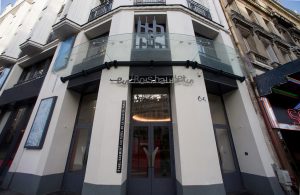 !
!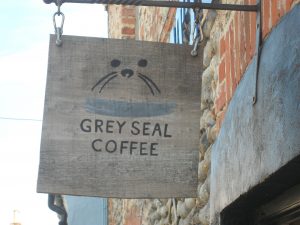 Walking and writing are such complementary activities. The rhythm of walking very much mirrors the rhythms of poetry and I often walk stuck ideas out into the open. I rarely want to write in the style of a flaneur when I’m out in the countryside, it’s very much an urban style after all, a bit like Frank O’Hara’s brilliant lunch poems – you need a busy scene with lots of people and activity and a slightly grungy feel to the whole scenario. When out and about in the great outdoors haiku are the perfect fit – I seem to compose them endlessly the minute I get a whiff of fresh air. This Japanese poetic style is much loved by Westerners. Short, delicate, just three lines and 17 syllables in total (although balance is more important than syllabic perfection), haiku are a great way to record impressions and their focus is usually the natural world and the seasons. The great Japanese haiku master was Matsuo Basho (1644-94), one of my favourites by Basho is:
Walking and writing are such complementary activities. The rhythm of walking very much mirrors the rhythms of poetry and I often walk stuck ideas out into the open. I rarely want to write in the style of a flaneur when I’m out in the countryside, it’s very much an urban style after all, a bit like Frank O’Hara’s brilliant lunch poems – you need a busy scene with lots of people and activity and a slightly grungy feel to the whole scenario. When out and about in the great outdoors haiku are the perfect fit – I seem to compose them endlessly the minute I get a whiff of fresh air. This Japanese poetic style is much loved by Westerners. Short, delicate, just three lines and 17 syllables in total (although balance is more important than syllabic perfection), haiku are a great way to record impressions and their focus is usually the natural world and the seasons. The great Japanese haiku master was Matsuo Basho (1644-94), one of my favourites by Basho is: One of the first feature films to be shot in Norfolk was The Rolling Road in 1927 starring Flora le Breton. Legend has it that the October sea at Great Yarmouth proved too much for the skimpily-clad heroine and she had to be saved by Carlyle Blackwell, her co-star, although some say she was saved not by the film’s hero but by Robert “Chickie” Drane, a Yarmouthian who was an acknowledged champion swimmer and lifesaver and allegedly doubled for Carlyle Blackwell in the aquatic scenes.
One of the first feature films to be shot in Norfolk was The Rolling Road in 1927 starring Flora le Breton. Legend has it that the October sea at Great Yarmouth proved too much for the skimpily-clad heroine and she had to be saved by Carlyle Blackwell, her co-star, although some say she was saved not by the film’s hero but by Robert “Chickie” Drane, a Yarmouthian who was an acknowledged champion swimmer and lifesaver and allegedly doubled for Carlyle Blackwell in the aquatic scenes.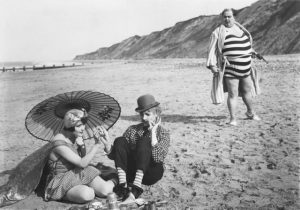 Another notable early film shot partly in Norfolk was Anthony Asquith’s 1928 Shooting Stars. Chili Bouchier won a competition in the Daily Mail to become a film star and here she is as a bathing belle on Cromer beach. One of our classic British films, The Go Between, starring Julie Christie and Alan Bates, was shot in Norfolk using locations at Thornage, Hickling Broad, Holkham, Heydon, Norwich, Melton Constable and Hanworth to evoke the hottest day of the year in 1900. Norfolk is so held in time that I often feel I am walking in the past evoked by these films, until my next stop for an expresso shot at the defiantly 21st century Grey Seal, that is!
Another notable early film shot partly in Norfolk was Anthony Asquith’s 1928 Shooting Stars. Chili Bouchier won a competition in the Daily Mail to become a film star and here she is as a bathing belle on Cromer beach. One of our classic British films, The Go Between, starring Julie Christie and Alan Bates, was shot in Norfolk using locations at Thornage, Hickling Broad, Holkham, Heydon, Norwich, Melton Constable and Hanworth to evoke the hottest day of the year in 1900. Norfolk is so held in time that I often feel I am walking in the past evoked by these films, until my next stop for an expresso shot at the defiantly 21st century Grey Seal, that is! Understandably, I’ve been writing a lot about place recently and I’ve been contemplating whether we remember places in black and white or colour. This has probably been further fuelled by a visit to the fantastic Henri Cartier-Bresson exhibition at the Sainsbury Centre for Visual Arts in Norwich. It’s a really well curated exhibition, spacious and meditative with peculiarly haunting images: boules players discussing strategy in the snow, ancient prams full of wartime finds, a photographer taking a group of gypsies, the heartbreaking faces of mourners after the Rue de Charonne massacre in the 1960s and this wonderful image of a cyclist and stairway. Strangely, when I think of Paris, the colours are very muted, almost wintery, in my mind. Other places appear in my memory in quite clichéd colours, so India is saffron and bright pink and Mexico memories are in earthy, sandy, almost terracotta colours. Try this yourselves, poets, it’s a good exercise – the colour of memory… It reminded me of all those films which play with the idea of black and white and colour – A Matter of Life and Death (where heaven is black and white and earth is in colour), Stalker – a Russian re-telling of the Wizard of Oz combined with the marvellous Strugatsky Brothers sci-fi novel Roadside Picnic – here the Zone is in colour (where your dreams come true) and the contaminated Russian industrial-scape is, of course, black and white.
Understandably, I’ve been writing a lot about place recently and I’ve been contemplating whether we remember places in black and white or colour. This has probably been further fuelled by a visit to the fantastic Henri Cartier-Bresson exhibition at the Sainsbury Centre for Visual Arts in Norwich. It’s a really well curated exhibition, spacious and meditative with peculiarly haunting images: boules players discussing strategy in the snow, ancient prams full of wartime finds, a photographer taking a group of gypsies, the heartbreaking faces of mourners after the Rue de Charonne massacre in the 1960s and this wonderful image of a cyclist and stairway. Strangely, when I think of Paris, the colours are very muted, almost wintery, in my mind. Other places appear in my memory in quite clichéd colours, so India is saffron and bright pink and Mexico memories are in earthy, sandy, almost terracotta colours. Try this yourselves, poets, it’s a good exercise – the colour of memory… It reminded me of all those films which play with the idea of black and white and colour – A Matter of Life and Death (where heaven is black and white and earth is in colour), Stalker – a Russian re-telling of the Wizard of Oz combined with the marvellous Strugatsky Brothers sci-fi novel Roadside Picnic – here the Zone is in colour (where your dreams come true) and the contaminated Russian industrial-scape is, of course, black and white. And if you do happen to be passing through Norwich, check out two fabulous cafes with their own roasteries and excellent craft coffee. Little Red Roaster is at 1a St Andrew’s Street, also 81b Grove Road and they have a good sized stall on the market too (52/53). Strangers Coffee Company on Dove Street are the new kids on the block and at present are for takeaways only. If you fancy tea (and cake!) the rather eccentric Biddy’s Tea Room is good for people-watching and writerly inspiration – tucked away on Lower Goat Lane, it’s got a slight air of the Mad Hatter’s Tea Party and has a monthly bake-off and a clothes swapping evening, both of which sound intriguing!
And if you do happen to be passing through Norwich, check out two fabulous cafes with their own roasteries and excellent craft coffee. Little Red Roaster is at 1a St Andrew’s Street, also 81b Grove Road and they have a good sized stall on the market too (52/53). Strangers Coffee Company on Dove Street are the new kids on the block and at present are for takeaways only. If you fancy tea (and cake!) the rather eccentric Biddy’s Tea Room is good for people-watching and writerly inspiration – tucked away on Lower Goat Lane, it’s got a slight air of the Mad Hatter’s Tea Party and has a monthly bake-off and a clothes swapping evening, both of which sound intriguing! I have just returned from an Arvon residential writing course taught by the most inspiring and generous poet-tutors one could possibly hope to have – Caroline Bird and Kei Miller. Kei is a Jamaican poet and we did a lot of work on ideas around place in his sessions, fitting in beautifully with my current obsession (he was very patient when I started every sentence with “In Paris…”); while Caroline stretched our perception of what poetry can do to an alarming and quite brilliant extent. All this took place in John Osborne’s old house, The Hurst, in the rolling English countryside near Clun. Heaven!
I have just returned from an Arvon residential writing course taught by the most inspiring and generous poet-tutors one could possibly hope to have – Caroline Bird and Kei Miller. Kei is a Jamaican poet and we did a lot of work on ideas around place in his sessions, fitting in beautifully with my current obsession (he was very patient when I started every sentence with “In Paris…”); while Caroline stretched our perception of what poetry can do to an alarming and quite brilliant extent. All this took place in John Osborne’s old house, The Hurst, in the rolling English countryside near Clun. Heaven!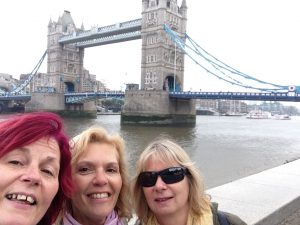 London, now there’s a place I always see in sepia… And most colour-appropriately I stayed there recently at an Airbnb in Bermondsey with two friends, Claire and Monika, who I hadn’t seen for around twenty-five years. We’d all been in Israel together, kept in touch for an intense seven or eight years and then drifted apart. We had a great weekend of catching-up and it felt as if we’d seen each other weeks rather than years ago.
London, now there’s a place I always see in sepia… And most colour-appropriately I stayed there recently at an Airbnb in Bermondsey with two friends, Claire and Monika, who I hadn’t seen for around twenty-five years. We’d all been in Israel together, kept in touch for an intense seven or eight years and then drifted apart. We had a great weekend of catching-up and it felt as if we’d seen each other weeks rather than years ago.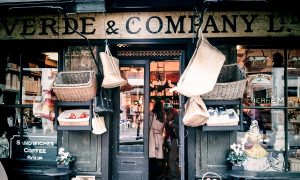
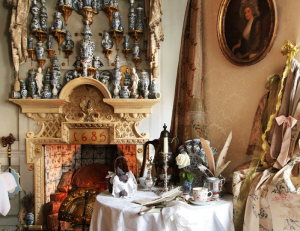 Which brings me neatly to my second London gem a stone’s throw from Verde and Company – Dennis Severs’ House at 18, Folgate Street. It’s not easy to describe this place and, be warned, it’s not open often, just Sundays and Mondays and your visit will be in complete, candlelit silence. Severs was an artist who lived in this house much as its 18th century inhabitants had before him and thirty years ago he decided to share this experience with visitors. The house is like a stage set and a time capsule, a series of paintings you stumble in to, seemingly just as the inhabitants have left – gaming dice flung on the table, a glass broken on the floor, a clock chiming, wistful traces of Huguenot weavers, the smell of oranges in the air… Each room creates a different mood and evokes different inhabitants. The house’s ten rooms harbour ten ‘spells’ that engage the visitor’s imagination in moods that dominated the periods between 1724 – 1914. Your senses are your guide. Severs called this experience “still-life drama” and it works beautifully. I’ve been going annually for years (I could swear the same black cat – yes, it’s definitely live! – skulks around the kitchen and front room, perhaps attracted to the cheeping of the stuffed canary…
Which brings me neatly to my second London gem a stone’s throw from Verde and Company – Dennis Severs’ House at 18, Folgate Street. It’s not easy to describe this place and, be warned, it’s not open often, just Sundays and Mondays and your visit will be in complete, candlelit silence. Severs was an artist who lived in this house much as its 18th century inhabitants had before him and thirty years ago he decided to share this experience with visitors. The house is like a stage set and a time capsule, a series of paintings you stumble in to, seemingly just as the inhabitants have left – gaming dice flung on the table, a glass broken on the floor, a clock chiming, wistful traces of Huguenot weavers, the smell of oranges in the air… Each room creates a different mood and evokes different inhabitants. The house’s ten rooms harbour ten ‘spells’ that engage the visitor’s imagination in moods that dominated the periods between 1724 – 1914. Your senses are your guide. Severs called this experience “still-life drama” and it works beautifully. I’ve been going annually for years (I could swear the same black cat – yes, it’s definitely live! – skulks around the kitchen and front room, perhaps attracted to the cheeping of the stuffed canary… And the third treasure is Wilton’s Music Hall in Graces Alley (about 10 minutes from Tower Hill tube station). The Victorian Music Hall itself is well worth a visit. I saw a fantastic production of The Great Gatsby there a couple of years ago, it’s a wonderful shabby chic space that takes you back to the Good Old Days! Best of all are the series of bar areas at the front of the music hall. Wilton’s started life as a series of five 17th century houses, the largest of which was a pub and which were later combined and subsequently bought and revamped by John Wilton in 1850. The Music Hall he built was popular for around thirty years, with acts like Champagne Charlie (check out the 1944 Ealing comedy Champagne Charlie with Stanley Holloway and Tommy Trinder.) treading the boards. There’s a good history of the site on the Wilton’s website
And the third treasure is Wilton’s Music Hall in Graces Alley (about 10 minutes from Tower Hill tube station). The Victorian Music Hall itself is well worth a visit. I saw a fantastic production of The Great Gatsby there a couple of years ago, it’s a wonderful shabby chic space that takes you back to the Good Old Days! Best of all are the series of bar areas at the front of the music hall. Wilton’s started life as a series of five 17th century houses, the largest of which was a pub and which were later combined and subsequently bought and revamped by John Wilton in 1850. The Music Hall he built was popular for around thirty years, with acts like Champagne Charlie (check out the 1944 Ealing comedy Champagne Charlie with Stanley Holloway and Tommy Trinder.) treading the boards. There’s a good history of the site on the Wilton’s website